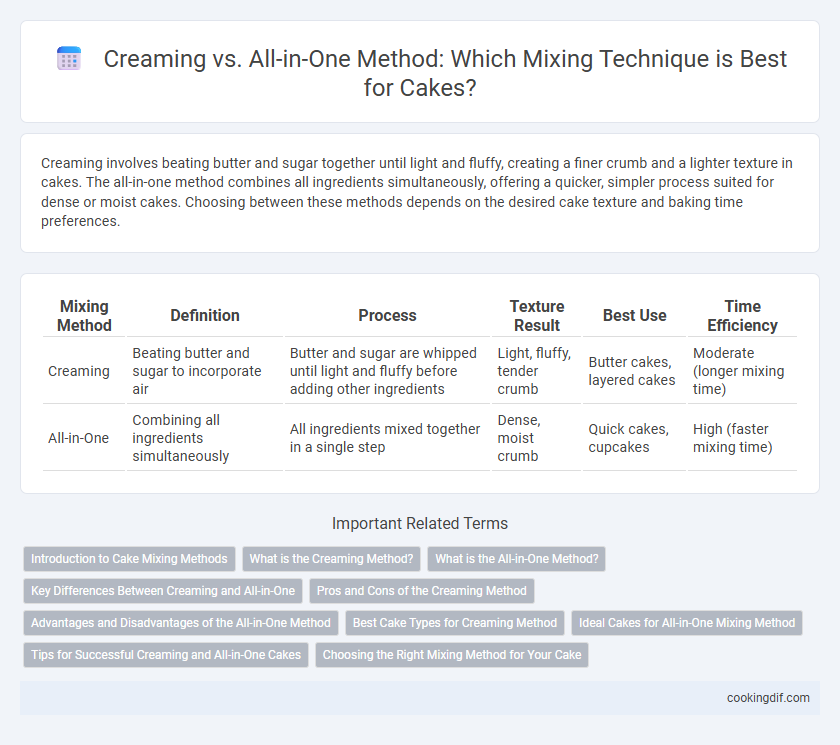Creaming involves beating butter and sugar together until light and fluffy, creating a finer crumb and a lighter texture in cakes. The all-in-one method combines all ingredients simultaneously, offering a quicker, simpler process suited for dense or moist cakes. Choosing between these methods depends on the desired cake texture and baking time preferences.
Table of Comparison
| Mixing Method | Definition | Process | Texture Result | Best Use | Time Efficiency |
|---|---|---|---|---|---|
| Creaming | Beating butter and sugar to incorporate air | Butter and sugar are whipped until light and fluffy before adding other ingredients | Light, fluffy, tender crumb | Butter cakes, layered cakes | Moderate (longer mixing time) |
| All-in-One | Combining all ingredients simultaneously | All ingredients mixed together in a single step | Dense, moist crumb | Quick cakes, cupcakes | High (faster mixing time) |
Introduction to Cake Mixing Methods
Creaming and All-in-One are two fundamental cake mixing methods that impact texture and crumb structure. Creaming involves beating butter and sugar until light and fluffy, incorporating air for a tender, airy cake, while the All-in-One method combines all ingredients simultaneously, simplifying preparation and producing a denser texture. Understanding these techniques allows bakers to choose the appropriate method based on desired cake type and consistency.
What is the Creaming Method?
The creaming method involves beating butter and sugar together until light and fluffy, creating small air pockets that help leaven the cake. This technique improves the cake's texture by producing a tender crumb and even rise. Creaming is essential for recipes that rely on butter as the primary fat and require a delicate, moist structure.
What is the All-in-One Method?
The All-in-One method combines all ingredients--flour, sugar, eggs, butter, and liquids--in a single bowl, streamlining the cake-making process and reducing preparation time. This efficient technique ensures even distribution of components, resulting in a consistently textured and moist cake. Popular for its simplicity, the All-in-One method suits beginner bakers and quick recipes without compromising flavor or structure.
Key Differences Between Creaming and All-in-One
Creaming involves beating butter and sugar together to create a light, airy texture, crucial for tender cakes, while the all-in-one method combines all ingredients simultaneously for quicker preparation but can result in denser crumb structures. Creaming allows better incorporation of air, leading to improved rise and fluffiness compared to the all-in-one technique. Cake recipes using the creaming method often require longer mixing times and precise ingredient temperatures, whereas all-in-one suits beginners aiming for convenience and speed.
Pros and Cons of the Creaming Method
The creaming method, involving beating butter and sugar until light and fluffy, creates a tender, fine-textured cake with superior rise due to aeration. It requires more time and effort compared to the all-in-one method, but produces consistent crumb structure ideal for butter-based cakes. However, improper creaming can lead to dense or uneven cakes, highlighting the need for precise technique and room-temperature ingredients.
Advantages and Disadvantages of the All-in-One Method
The All-in-One mixing method simplifies cake preparation by combining all ingredients simultaneously, which saves time and reduces the number of steps needed. This method can result in denser cakes due to less air incorporation compared to the Creaming method. While convenient for beginners and quick recipes, it may compromise texture and rise, making it less ideal for delicate or highly aerated cakes.
Best Cake Types for Creaming Method
The creaming method is ideal for light and airy cakes such as pound cakes, butter cakes, and classic layer cakes because it incorporates air into the butter and sugar, creating a fluffy texture. This technique works best with recipes containing a higher fat content, helping to achieve a delicate crumb and tender bite. Cakes like vanilla sponge and chocolate butter cakes particularly benefit from the creaming method's ability to produce a moist and evenly risen result.
Ideal Cakes for All-in-One Mixing Method
The All-in-One mixing method is ideal for simple, everyday cakes such as sponge cakes, pound cakes, and basic butter cakes, where speed and convenience are priorities. This method involves combining all ingredients simultaneously, promoting faster preparation while still achieving a tender crumb and moist texture. Cakes mixed with the All-in-One method often result in a slightly denser structure compared to the lighter, airier cakes produced by the Creaming method.
Tips for Successful Creaming and All-in-One Cakes
For successful creaming, ensure butter is softened to room temperature and beat it with sugar until light and fluffy to incorporate air, which creates a tender cake crumb. When using the all-in-one method, thoroughly combine all ingredients in one bowl but avoid overmixing to prevent a dense texture. Both methods benefit from precise measurement of ingredients and avoiding excessive mixing to maintain cake structure and moisture.
Choosing the Right Mixing Method for Your Cake
Choosing the right mixing method for your cake depends on the desired texture and recipe type. The creaming method, which involves beating butter and sugar until fluffy, is ideal for cakes requiring a light, airy crumb, such as butter cakes and pound cakes. The all-in-one method, where all ingredients are combined simultaneously, suits denser cakes like fruitcakes and sponge cakes, streamlining preparation and ensuring even mixing.
Creaming vs All-in-One for mixing method Infographic

 cookingdif.com
cookingdif.com